Street food is one of the best ways to experience a country’s culture, but what feels casual and laid-back in one place can be a serious faux pas in another.
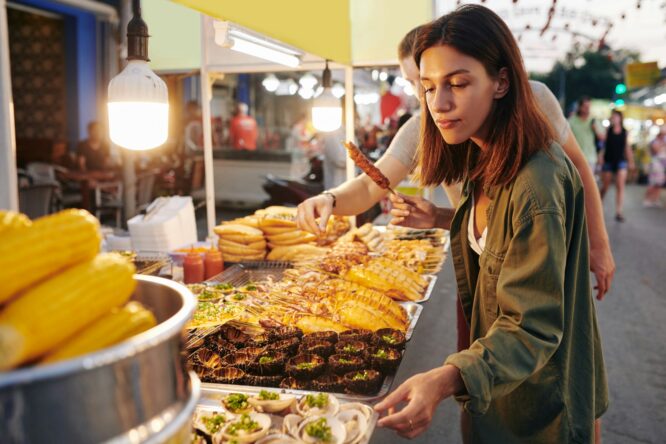
Knowing how to behave at stalls, how to eat, and even where to stand can make the difference between blending in and accidentally offending someone. So before you dive into that delicious-looking skewer or crispy dumpling, it’s worth knowing the unspoken rules. Here are 13 street food etiquette tips from around the world to help you eat respectfully and confidently wherever you go.
1. In Japan, avoid walking while eating.

Japanese culture places a high value on tidiness and mindfulness, especially around food. It’s considered impolite to walk and eat at the same time, even if you’re grabbing something quick from a street vendor.
If you do buy street food, look for a nearby bench, designated area, or even just stand to one side to finish it before moving on. You’ll be respecting local norms and enjoying the food more mindfully, which is exactly how it’s meant to be experienced.
2. In Thailand, go easy on the condiments.

Thai street food often comes perfectly seasoned, and while there are condiments available at most stalls, loading up your dish before tasting it can come across as rude or disrespectful to the cook.
It’s best to taste first, then adjust gently if needed. The sauces and spices on offer are there to enhance, not overhaul. Being thoughtful with your adjustments shows appreciation for the cook’s skill, which goes a long way in Thai food culture.
3. In Mexico, keep it casual but respectful.
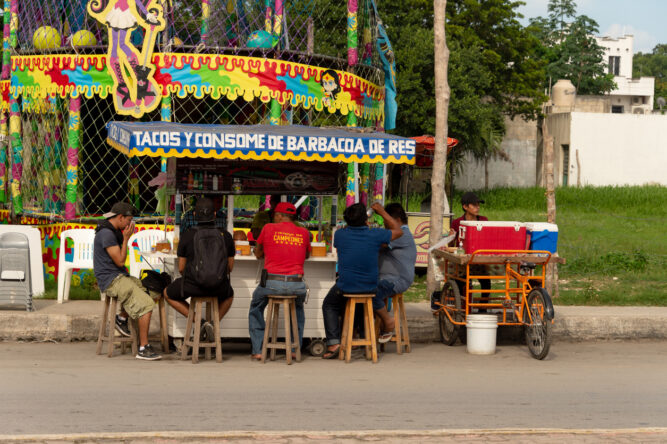
Street food in Mexico is lively, busy, and very much a community affair. It’s fine to eat standing or sitting on a curb, and vendors often appreciate friendliness and a bit of small talk if things aren’t too hectic. What’s not appreciated? Acting like you’re at a restaurant. Don’t try to customise everything or take forever deciding. Be polite, be quick, and be ready to enjoy it with your hands — just don’t forget to say “gracias.”
4. In India, use your right hand to eat.

In many parts of India, the left hand is considered unclean and isn’t typically used for eating, especially with street food, which often involves tearing bread or scooping with your fingers. If you’re using your hands, stick to the right one, and try to avoid touching shared items with your left. It might feel awkward at first, but locals will appreciate the effort, and you’ll fit in more easily at the stalls.
5. In France, don’t eat messy food on the go.
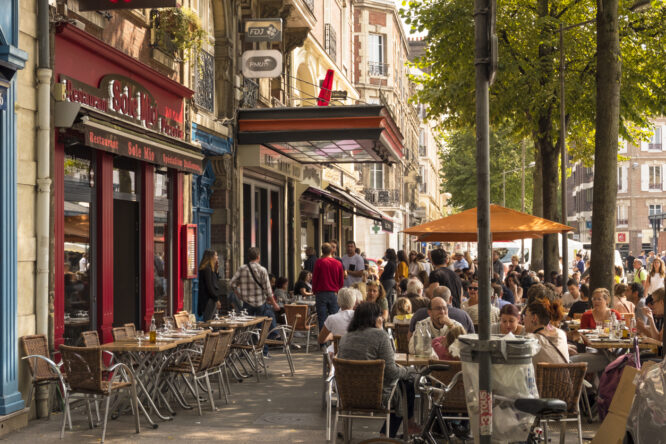
France might not be the first place you think of for street food, but you’ll find crêpes, baguette sandwiches, and pastries almost everywhere. That said, eating something super messy or loud while walking isn’t the norm. Even casual meals are approached with a bit of care. Find a quiet corner, sit in a park, or stand respectfully nearby — and whatever you do, don’t treat the streets like a picnic table. A bit of elegance goes a long way here.
6. In Vietnam, follow the locals’ lead.
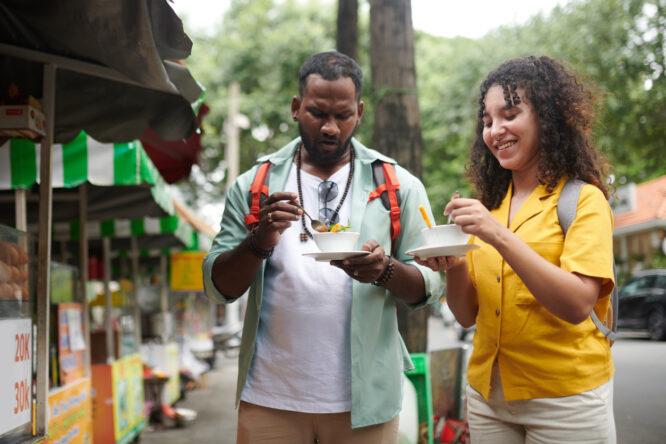
Vietnam’s street food culture is incredible, but it’s often fast-paced and very local. Seating is usually low to the ground and shared, so don’t hesitate to squeeze in beside someone and join the flow. It’s not the place for long, leisurely meals or picky orders. Watch how others eat — including how they dress sauces or use chopsticks — and match the vibe. Locals appreciate visitors who respect the rhythm rather than try to reinvent it.
7. In Singapore, return your tray and clean up.
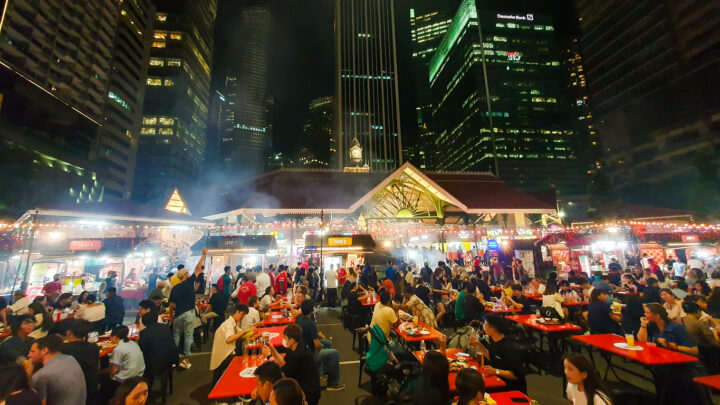
Singapore is famously clean, and that expectation extends to food courts and hawker centres. When you finish eating, it’s polite (and sometimes required) to return your tray and tidy up your space. Don’t leave behind tissues, cups, or food scraps — and definitely don’t expect someone else to do it for you. This small action is a big sign of respect in a place where order and cleanliness are part of everyday life.
8. In Italy, keep it simple and savour it.

Even Italian street food comes with a sense of occasion. Whether it’s pizza al taglio or arancini, it’s expected that you enjoy your food with appreciation, not as a rushed afterthought between errands. It’s not common to eat while walking unless it’s something like gelato. So pause, stand nearby, and enjoy it fully. Italians care about food deeply, and showing that you do too is the best compliment you can give.
9. In South Korea, respect quiet queues.
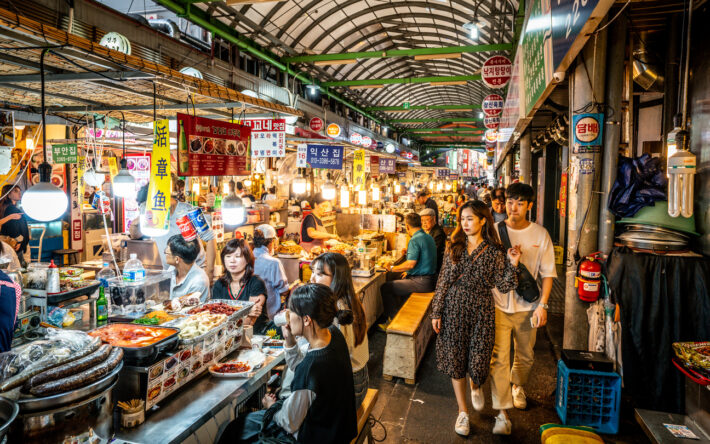
Street food is wildly popular in South Korea, especially at night markets, but queuing quietly and patiently is the norm. There’s no shouting over someone else or crowding the stall. Wait your turn, order efficiently, and move aside once you have your food. Many locals also quietly move to designated eating zones, even if informal. The experience is quick but respectful, and the unspoken rules keep everything running smoothly.
10. In Turkey, tipping isn’t expected, but respect is.

Turkish street vendors usually don’t expect a tip, but they absolutely expect basic manners. A friendly greeting, a thank you, and a genuine compliment on the food go a long way. It’s a culture where pride in food preparation is high, so treating vendors with warmth and respect creates a better experience for everyone. You’ll often get better service and maybe even a bigger portion in return.
11. In Morocco, use bread like a utensil.
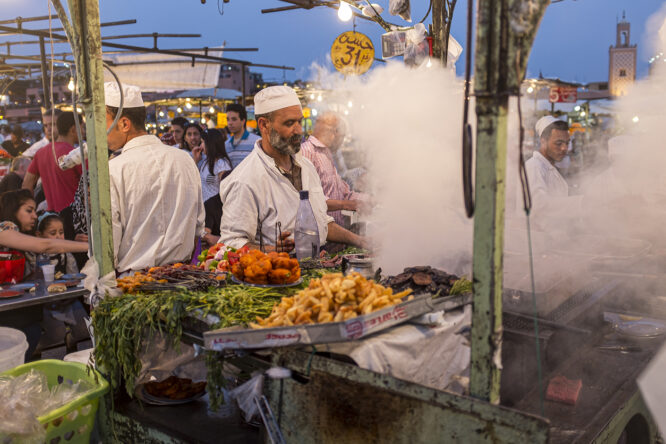
In Morocco, flatbread is often used to scoop up food, even in casual street settings. If you’re unsure, watch how others are eating and follow suit — it’s an easy way to show you’re engaged with the culture. It’s also worth noting that eating with your right hand is the norm here too. And if something is shared, try to only touch your portion. A little attentiveness goes a long way in these communal food moments.
12. In the U.S., be mindful of tipping norms.
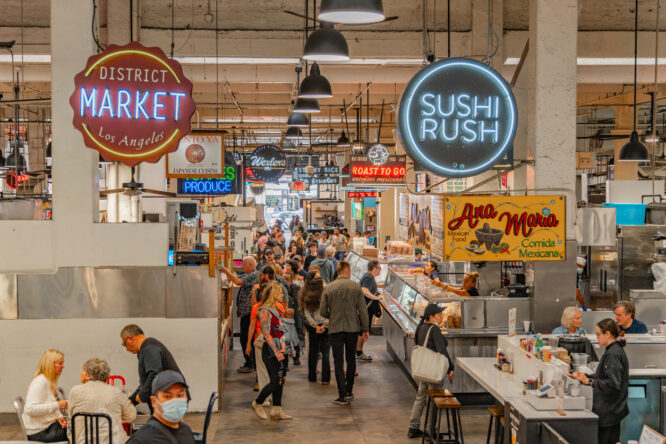
While tipping at a food truck or cart isn’t always expected, in many American cities it’s becoming more common. If there’s a tip jar or screen prompt, rounding up or leaving a small amount is a nice gesture. It’s also good etiquette to step aside once you get your food to keep the line moving. Street food is often fast, but that doesn’t mean it’s rushed — just efficient and friendly.
13. In Brazil, try not to snack without acknowledging the vendor.

Brazilian street food is vibrant and social — but if you grab something like pastéis or churros, always make eye contact, say hello, and pay before you start munching. Eating before paying can feel disrespectful or rushed in many areas. Vendors value friendliness and respect, and a bit of small talk can make the whole exchange feel warmer. You’re not just buying food — you’re part of a moment. A little acknowledgment goes a long way.




